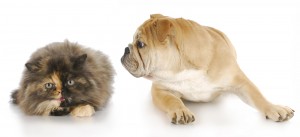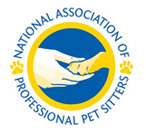Is it a nature or nurture thing for animals of different species to get along?
Why do some breeds seem more likely to pursue cats?
After checking dog versus cat websites and authorities, there are a number of theories about how to training your cat and dog to get along.
Also coming into play is the fact that certain breeds that do better co-existing with cats (see below).
Having said that, HOW you introduce your new pet to the existing pets is very important.
The key to building a good relationship is:
1. Start with the new pet in a crate/contained area for the first few days.
That way your other pets can sniff it and get used to its smell/sounds.
2. Have short, supervised visits for the new pet and make sure the dog is tired out first (after a walk is a good time).
3. Make sure to praise and reward your first pet when they sniff the new member and then leave it alone.
The key command “Leave it” will greatly help with dogs.
4. If you know someone that has a cat-friendly dog, invite them over to your home, allowing the cats in your household to get more familiar with the smells that accompany a dog.
5. Feed your new pet and resident pet on each side of a closed door – not too close though initially. “That way they associate something positive (food) with the other animals smell.
Slowly move the dishes closer each day”. -Humane Society
6. The ASPCA recommends “rotating which animal has freedom and which is confined to allow each animal plenty of time to investigate the other one’s scent for the first few days.
Sometimes the dog should be confined to a crate or another room (or taken to another location if he can’t be left alone) to allow the cat time to roam free and investigate the smell of the dog”.
*Always make sure the cat has somewhere it can jump up to get away if needed.
Make sure to “provide plenty of positive reinforcements for appropriate behavior as an incentive to get your dog to continue to behave well in the cat’s presence” -Humane Society.
So, what dog breeds are best for getting along with a kitty? A lap dog with lower energy, easily trained, and a gentle manner.
Good small breed choices: Pekingese, Pomeranian, Bichon Frise, Shih Tzu, Chihuahua, Maltese, Cavalier King Charles spaniel, Shetland Sheepdog and Chinese Crested.
Good large breed choices: Labrador, Poodle, English Setter, Bernese Mountain Dog, Golden Retriever, Sussex Spaniel
What breeds have more of a personality conflict with cats? Breeds that were developed to chase after small prey, like rabbits or squirrels.
Their instincts may take over and they could pursue the cat, unintentionally hurting it.
Listed below are breeds that may take more work to teach them how to act around cats.
Many instinctively chase after smaller creatures so you will be re-training what they are hard-wired to do: pursue!
A southern-bred hunting dog, the Bluetick Coonhound, can be stubborn and hard to train to not pursue cats.
The Alaskan Malamute and Australian Cattle Dog both have a high prey drive, along with Whippets, Greyhounds, Saluki and the German Pinscher.
Both the Fox Terrier and Manchester Terrier were bred to hunt rats and have a high stamina for pursuit.
The Afghan Hound has a strong interest in chasing small animals like cats.
Weimaraners are also know to be extremely aggressive towards cats.
Remember, the initial visits must be supervised, and with time the pets will slowly come to know each others scent and behaviors.
Of course there will still be days where they chase each other – like cats and dogs!











